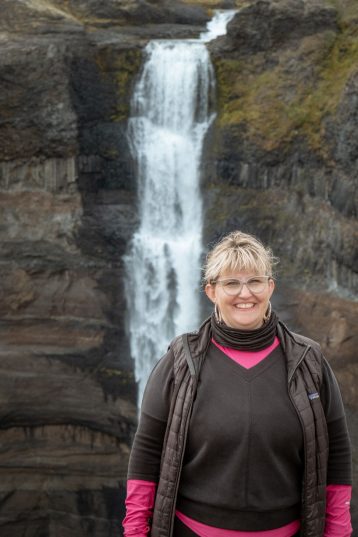For many, gardening is akin to their happy place, enabling them to enter a zen-like state, surrounded by fragrant and blooming beauties.
But for Korrin Schriver, it’s more than that. It’s a science and an agricultural way of a sustainable future.
The 36-year-old who has taught science at Wahlert Catholic High School in Dubuque for the past six years is at the forefront of a re-emerging technology that combines gardening and science in an innovative and natural way.
Schriver and her husband, Sean, are in the process of developing aquaponics and hydroponics systems for Convivium Urban Farmstead in Dubuque.
“My husband and I lived in the Milwaukee area for eight years during our college studies, and prior to coming to Dubuque, and we were introduced to an organization called Growing Power,” Schriver explained.
The now defunct urban agricultural organization launched in 1993 by former professional basketball player Will Allen was known for its efforts in sustainable food production, as well as creating local gardens and advocating for community food systems. Growing Power shuttered its doors in 2017.
Yet, growing up on a “hobby farm” and with a deep interest in science and a love for the outdoors, Schriver was intrigued about how she could make the effort successful.
Upon relocating to Dubuque and becoming acquainted with Leslie Shalabi and Mike Muench, who founded Convivium, Schriver believed she had found just the right outlet, with a mission to match.
Shalabi agreed.
“The agreement we have is that we’ll pay for the restoration and the capital for the equipment,” she said. “Once everything is up and running, Korrin and Sean will essentially be their own entity. We’re hoping that Convivium will be a major consumer from that. The benefit to us is that we will have fresh, local produce just steps from our door, all year-round.”
It’s a massive work in progress.
In 2015, Schriver and her husband began restoring one of two of the 1920s-era greenhouses on Convivium’s Jackson Street property, as well as planning and integrating aquaponics and hydroponics systems.
The establishment that carries a namesake Latin for “feast” also includes outdoor gardens, a permaculture orchard, a commercial kitchen, a learning center and dining and event space.
Schriver sees aquaponics and hydroponics systems as enhancements to Convivium, an organization already making strides in food outreach and education in the community.
“It’s a way to continue giving back, in a sense,” said Schriver, who is not only doing the restoration work with her husband but also is financially supporting the effort. “And it’s a way to promote gardening and agricultural practices that are good in the long term.”
How it works
Aquaponics combines traditional aquaculture, such as raising aquatic animals, with hydroponics, which cultivates plant life in water.
For the system to work successfully, three components are essential: Fish, plants and bacteria.
Fish in a tank produce ammonia-rich waste, which is pumped with water to a flood tank. That tank empties nutrient-rich water into a grow bed, feeding the plants and filtering the water. Bacteria is cultured in the grow beds and fish tank, which breaks the ammonia into nitrites, then nitrates. Lastly, aerated water returns to the fish tank, and the cycle repeats.
Hydroponics relies on growing plants without soil and instead, using mineral nutrient solutions in a water solvent.
Both would benefit the efforts at Convivium. The organization emphasizes farm-to-table initiatives through growing, preparing, preserving and enjoying food, as well as implementing educational and community outreach for youth and adults.
While it might seem revolutionary, the practices date back to the Aztecs. Chinese agricultural practices also have made use of floating aquaponics systems for centuries.
“There is a lot of science behind it,” Schriver said. “But it’s nothing that those who came before us hadn’t been using. That’s part of what’s so fascinating about it.”
Freshwater fish, such as the tilapia Schriver and her husband plan to use in their system, are the most common aquatic animal raised using aquaponics. The clean, white fish are tolerant to crowding.
The Schrivers’ design will include a series of 40-foot floating beds as part of the system, situated throughout the approximately 3,000 square feet of greenhouse space at Convivium.
“The big challenge is in getting a 1920s greenhouse to operate as a modern day greenhouse,” Schriver said.
Moving forward
Their’s is smaller in scale in comparison to similar efforts, Schriver said — several of which haven’t always found the their success as sustainable as their systems.
“We’ve spent a lot of time looking into why some of these organizations fail, and many that have seemed to be operations that got big fast,” Schriver said. “Others used fish that perhaps weren’t as tolerant to crowding or materials like troughs which weren’t easy to remove waste. We plan to get our feet wet and start out small.”
Once successfully up and running, they also hope to share tips for others wanting to implement aquaponic and hydroponic systems in their practices.
Schriver pointed to FarmTek, known for its hydroponic systems, and Iowa State University Education and Outreach as being instrumental in assisting the couple’s efforts.
Others have been more guarded.
“We’ve worked with many and have found some not to be as open or willing to visit with us about what has made them work,” Schriver said. “On one hand, I understand them not wanting to create competition. But on the other, I would like to see us be an educational outlet for others. Maybe that’s the teacher in me, but I’d like that to be part of our mission and see this grow locally.”
Schriver also has developed a small system in her Wahlert classroom for students to test the waters.
“It’s exciting to see nature do what nature does best,” she said. “It’s especially nice to foster that curiosity in my science classes.”
Schriver and her husband also are implementing that effort on the home front, having purchased and relocated to a small swath of land where they can grow food, just blocks from Convivium.
“I’m happy to be working within Convivium’s mission,” Schriver said. “No matter how much we grow.”
That mission, to not only emphasize community but education surrounding food.
“We’re very excited to be a part of that,” Shalabi said. “And Korrin brings such an enthusiasm for it, with her strong analytical science mind in combination with being a really great teacher. Sean also compliments that with his knowledge of construction and engineering. It’s a nice partnership.”
Megan Gloss writes for the Telegraph Herald.











